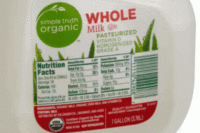
More Choices, But Tough Battles
Excerpted from Dairy Field’s December 1995 State of the Industry report.
Despite changing eating
trends, consumers continue to spend more than 10 percent of their food
budget on dairy products, a number that has varied only slightly in the
past 20 years. Milk, cheese, ice cream and cultured products remain staples
in most American diets. In fact, USDA and the Milk Industry Foundation
(MIF) estimate that consumers spent a record $67.5 billion on dairy
products in 1994.
To its credit, the industry has done a good job of
adjusting its products to consumer demands. Today, there is a broad range
of reduced-fat and nonfat dairy product choices, with more package size and
flavor choices than ever.
Staying attuned to the consumer will be increasingly
important as the federal government considers dismantling the elaborate
regulatory pricing system that has supported the U.S. dairy industry for
decades.
At the same time, consolidation continues at a steady
pace; every year there are fewer dairy companies and fewer plant
operations, replaced by larger companies and plants serving larger regional
territories.
Some categories in the dairy portfolio have fared
better than others in recent years. Consumers continue to drink less milk,
a phenomenon the milk industry blames on its own lethargy in marketing over
the past two decades. In response, the industry has united and launched
powerful new marketing programs, the results of which are still being
measured.
Frozen desserts and cheese continue to be strong,
steady dairy categories. Innovation in lower-fat ice creams and frozen
yogurts has been a boost to frozen dessert marketers. Cheesemakers have
pizzas, prepared foods, pasta and other American favorites to thank for
record-breaking production levels.
Meanwhile, on the farm, milk production continues to
grow. More than 153 billion pounds of milk was produced in 1994, a 2
percent increase over 1993. 1995 milk production is estimated to near 156
billion pounds, MIF reports. According to USDA, the 10 largest
milk-producing states, in order, are California, Wisconsin, New York,
Pennsylvania, Minnesota, Texas, Michigan, Washington, Idaho and New Mexico.
Looking at milk-consumption figures for 1994 and the
first three quarters of 1995, one might conclude that nothing new is
happening in this enormous sector of the dairy business. The slowly
declining line that reflects a 20-year drop in per capital milk consumption
continues to sag, though rising skim milk sales improve the picture
somewhat.
What the numbers don’t show is the flurry of
processor- and producer-funded milk marketing that has occurred nationwide
in 1995 and will continue in ’96. Processors are banking on their $53
million “Milk. What a Surprise!” milk mustache print ads and
other MilkPEP (Processor Education Program) campaign activities to begin to
stem the drop in milk consumption. Another effort, “got milk?,”
initiated by California processors in 1994, has been picked up nationally
by producers to further promote milk sales, mostly through television
advertising.
Nonetheless, by most accounts, it may be another year
before processors can hope to see a jump in the sales needle. That’s
because some coordinated efforts are just now moving into full swing; and
the makers of MilkPEP say the campaign is still geared toward removing
barriers to milk sales — namely, changing negative perceptions and
misconceptions that consumers have about milk. m
70 Years Not a Lifetime, but Time to Reflect and
Evaluate the Future
When one turns 70, it is
time to reflect upon past and possible future contributions to friends,
neighbors, loved ones, the community and society in general. It is a time
to evaluate whether past and current activities are appropriate for the
future.
After 70 years of existence, the Social Security
program is receiving the focus and attention it needs and deserves. The
Social Security program, started under President Roosevelt in 1935, has
served several generations of senior citizens, but is now in clear need of
change to reflect current realities.
Federal milk marketing orders and their predecessor
programs were authorized in 1933, two years before the Social Security
program. This program also deserves reflection, evaluation and analysis. It
is time to take a hard look at where dairy-based foods and beverages fit in
the world of new products that may look like beverages in that they are
drinkable, but are formulated with many non-dairy ingredients and are
regarded by consumers as foods, snacks, meal replacements or nutritional
supplements.
The need for an introspective look at the USDA’s
price classification policies was painfully apparent at its mid-June
hearing to consider changing the current Class I definition. Witnesses
raised recurring questions about whether the program was really enhancing
dairy farmer revenues, whether it hindered the use of dairy ingredients by
providing an incentive to use non-dairy ingredients and whether it
negatively impacted incentives to create new products and develop
innovative marketing programs.
The primary justification for price classification is
to obtain greater revenues for dairy farmers than they would otherwise
obtain without classified pricing. During the hearing there were
substantial doubts raised about whether classified pricing — and
especially extending Class I pricing to non-dairy beverage products
containing small amounts of dairy-derived ingredients — would enhance
producer revenues or decrease them. Cornell University presented extensive
analysis showing the effect on dairy farmer revenues from the
reclassification of new products from Class II to Class I is likely to be
small (plus or minus less than one cent/cwt).
However, if the reclassification results in the
substitution of non-dairy ingredients for dairy ingredients, then the
negative impact on producer revenues is much greater (minus 23 cents/cwt).
The Cornell professor concluded, “There is little upside potential
from reclassification, but significant downside potential.”
Other witnesses, including yours truly, presented
other studies that clearly cast doubt on whether classified pricing is or
can, in fact, enhance producer revenues in view of the burgeoning number of
alternative drinkable products in the market. New price elasticity studies
report that many types of milks are more price responsive now than they
were historically.
Another major issue was whether the present rule that
excludes Class I beverage products containing less than 6.5 percent nonfat
milk solids should be changed. Dairy farmer cooperatives urged that the
exclusion be changed to apply to beverage products containing dairy-derived
ingredients, but only if they contain less than 2.25 percent milk protein.
It was quickly pointed out by many that such a move
would effectively cap the amount of dairy protein used in such products to
avoid Class I classification. Other protein sources, such as soy, could be
added if a higher protein level was desired. This is similar to the
scenario modeled by Cornell and was strongly opposed by a major producer of
sophisticated whey proteins because they thought it would greatly limit the
market for whey proteins. In fact, virtually all witnesses, except those
representing cooperatives, opposed the protein cap.
I suggest the time has come for the USDA to initiate a
non-rule-making, fact-finding process to reflect on past and future
contributions of this septuagenarian program. There are legitimate
questions as to whether it is still enhancing producer revenues. The answer
should be aggressively sought by all interested parties — producers,
processors, consumers and, yes, the government. It would be a terrible
shame if dairy farmer revenues are being unnecessarily reduced in order to
perpetuate this antiquated program.
Let us know how you feel: tip@tiptongroupdc.com.
Tip Tipton, chairman and chief executive officer of
the Washington, D.C.-based Tipton Group, is the former CEO of the
International Dairy Foods Association.
$OMN_arttitle="More Choices But Tough Battles";?>

